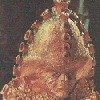The Doctor Doctor Who Monsters The TARDIS Doctor Who Fans First Doctor Second Doctor Third Doctor Fourth Doctor Fifth Doctor Sixth Doctor Seventh Doctor
Eighth Doctor Ninth Doctor Tenth Doctor
Doctor Who News & Articles Blog

 The
Zygons appeared only in the classic 1975 story Terror of the Zygons.
The fourth
Doctor was
called back to Earth in the 1980s by the Brigadeer. Three of the shape-shifting
Zygons, an advance scouting party for an invasion force, had been living for
the last few centuries near Loch Ness. I always liked the look of the Zygons
and their organic machines, which appeared to be more grown than made. The
excellent costumes made the Zygons one of the most visually effective aliens
from the original series (and still look better than at least one alien I can
think of from the new series). This was the last UNIT story for over ten years,
and was the last story to feature companion Harry
Sullivan.
The
Zygons appeared only in the classic 1975 story Terror of the Zygons.
The fourth
Doctor was
called back to Earth in the 1980s by the Brigadeer. Three of the shape-shifting
Zygons, an advance scouting party for an invasion force, had been living for
the last few centuries near Loch Ness. I always liked the look of the Zygons
and their organic machines, which appeared to be more grown than made. The
excellent costumes made the Zygons one of the most visually effective aliens
from the original series (and still look better than at least one alien I can
think of from the new series). This was the last UNIT story for over ten years,
and was the last story to feature companion Harry
Sullivan.
 The Ogrons:
The Ogrons:The Ogrons, mercenary ape-men who often worked for the Daleks,
appeared in two of the third Doctor's stories: Day of the Daleks in
1972, and Frontier in Space in 1973.
 Only one Daemon, Azal,
was ever seen on Doctor Who. Azal was one of a powerful extra-terrestrial race
which inspired myths and legends in many religions of horned demons with cloven
hooves. The 1971 episode, The Daemons, was one
of just three Doctor Who stories which had five parts (instead of the more common
four or six), and also featured the Master who summoned
Azal. The other two five-part stories were
the 1968 stories, The Dominators and The Mind Robber, which are
two of the six second
Doctor's stories which exist in their complete form.
Only one Daemon, Azal,
was ever seen on Doctor Who. Azal was one of a powerful extra-terrestrial race
which inspired myths and legends in many religions of horned demons with cloven
hooves. The 1971 episode, The Daemons, was one
of just three Doctor Who stories which had five parts (instead of the more common
four or six), and also featured the Master who summoned
Azal. The other two five-part stories were
the 1968 stories, The Dominators and The Mind Robber, which are
two of the six second
Doctor's stories which exist in their complete form.

 The
Rutans appeared in one story, The Horror of Fang Rock, but were mentioned
in other stories,
The
Rutans appeared in one story, The Horror of Fang Rock, but were mentioned
in other stories,
While not precisely a monster, Mary Whitehouse almost deserves the title for
she dogged theDoctor's steps with her campaigns against violence in British
television starting in the sixties. She frequently targeting Doctor Who specifically,
despite admitting that the show had a certain brilliance.
In her defense, Ms. Whitehouse was apparently under the impression
that Doctor Who was aimed at very young children, rather than pre-teens and
a family audience, which probably caused her many critical remarks.